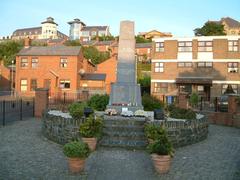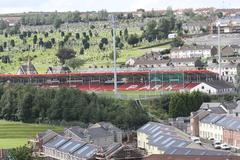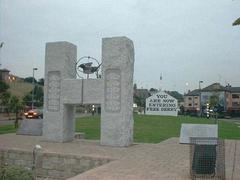Londonderry Graving Dock Railway Station: Visiting Hours, Tickets, and Historical Significance in Derry
Date: 04/07/2025
Introduction
Londonderry Graving Dock Railway Station, established in 1863, is a key landmark in Derry’s industrial and transport heritage. As the original terminus of the Londonderry and Lough Swilly Railway (LLSR), the station was strategically located beside the River Foyle’s graving dock, facilitating seamless transfers between maritime and rail transport. This guide offers a comprehensive overview of the station’s history, architectural features, operational significance, and practical visitor information, including visiting hours, ticketing, accessibility, nearby attractions, and travel tips—ideal for heritage enthusiasts and travelers seeking to explore Derry’s remarkable past (Railscot, BBC Your Place and Mine, Wikipedia).
Table of Contents
- Historical Development of Londonderry Graving Dock Railway Station
- Architectural Features and Urban Integration
- Operational Significance and Decline
- Visiting Information: Hours, Tickets, and Accessibility
- Nearby Attractions and Heritage Experiences
- Practical Travel Tips
- Frequently Asked Questions (FAQs)
- Visual Resources
- Conclusion and Further Reading
Historical Development of Londonderry Graving Dock Railway Station
Early Years and Growth (1863–1900)
Opened in 1863, Londonderry Graving Dock Railway Station served as the LLSR’s urban gateway, linking Derry to rural Donegal and the Inishowen Peninsula. Its proximity to the graving dock enabled efficient transfer of goods—especially agricultural produce, fish, coal, and textiles—from ship to rail, underpinning Derry’s prominence as a commercial port (Railscot).
Integration with Urban Networks
A unique aspect of the station was its connection to the Londonderry Port and Harbour Commissioners’ tramway, which ran along the River Foyle, linking the station to the city center’s Middle Quay. This multi-modal transport system streamlined the city’s logistics and improved accessibility for both freight and passengers (BBC Your Place and Mine).
The Era of Multiple Termini
Derry was once served by four passenger railway termini, reflecting its status as a transport hub:
- Graving Dock Station: Served the LLSR and western destinations.
- Foyle Road Station: Linked to Enniskillen via the Londonderry and Enniskillen Railway.
- Victoria Road Station: Connected to Strabane via the Donegal Railway Company.
- Waterside Station: Served the Belfast route.
Freight lines interconnected these stations, emphasizing Derry’s commercial significance (Wikiwand).
Decline and Closure
By the mid-20th century, the rise of road transport and railway rationalization led to a decline in rail services. The Graving Dock station closed to passengers in 1948 and to freight in 1953, ending its direct transport role but leaving an enduring legacy in Derry’s urban fabric (Wikipedia).
Architectural Features and Urban Integration
Station Design and Dockside Operations
The station featured robust masonry and timber construction, covered platforms for weather protection, and extensive sidings for freight. Its placement beside the graving dock allowed direct rail access to ship-repair facilities—a crucial advantage before modern road haulage (BBC Your Place and Mine).
Platform and Track Configuration
Multiple platforms and sidings supported both passenger and freight operations. The 3-foot narrow-gauge track design was chosen for its suitability to the region’s topography and urban setting.
Integration with City Infrastructure
The Craigavon Bridge’s rail deck facilitated cross-river freight movement, linking termini on both sides of the River Foyle and exemplifying the city’s multi-modal transport solutions.
Operational Significance and Decline
Economic and Industrial Impact
The station was vital for regional commerce—supporting the transfer of coal, textiles, and agricultural products between Derry’s factories, ships, and rural suppliers. It played a role in the city’s population growth and industrial expansion (Ulster Museum Textile Collection).
Social and Cultural Influence
The station linked diverse communities, enabled daily commuting, and was central to emigration journeys. During both World Wars, it facilitated military logistics and contributed to Derry’s role as an Allied naval base (Imperial War Museums).
Legacy
Although the original station structures are largely gone, the site’s significance endures in Derry’s collective memory, urban landscape, and ongoing heritage initiatives (Visit Derry).
Visiting Information: Hours, Tickets, and Accessibility
Visiting Hours and Tickets
The former Londonderry Graving Dock Railway Station site is now part of the city’s docklands and is freely accessible at any time, integrated within public urban space. There are no entry fees or ticket requirements for the site itself.
Nearby museums (such as the Tower Museum and Museum of Free Derry) have their own opening hours and ticket prices. For the latest details, visit the Visit Derry website.
Accessibility
- The docklands and Greenway paths are wheelchair accessible, with step-free routes and amenities nearby.
- Visitor centers and major museums offer accessible restrooms and support for those with mobility needs.
Nearby Attractions and Heritage Experiences
- Derry~Londonderry Railway Station (North West Transport Hub): The city’s active rail station, featuring the longest platforms in Northern Ireland (Wikiwand).
- Tower Museum: Exhibitions on Derry’s maritime and transport history.
- Museum of Free Derry: Focus on the city’s social and political past.
- Derry City Walls: One of Europe’s best-preserved walled cities.
- Peace Bridge: A modern pedestrian bridge linking the city center with the Waterside area.
Heritage walking tours and self-guided trails, available through the Derry Visitor Information Centre, often include the former station site and docklands.
Practical Travel Tips
- Best Time to Visit: Spring through autumn offers favorable weather for walking tours and exploration.
- Getting There: The site is within walking distance from Derry’s city center and train station. Public transport and parking are available.
- Visitor Facilities: The Derry Visitor Information Centre provides maps, guides, free Wi-Fi, and accessible amenities.
Frequently Asked Questions (FAQs)
Q: What are the visiting hours for the former station site?
A: The site is open and freely accessible at all times as part of public space.
Q: Are tickets required?
A: No tickets are required for the site itself. Tickets may be needed for museums and guided tours.
Q: Is the site wheelchair accessible?
A: Yes, with flat pavements and step-free access in most areas.
Q: Are guided tours available?
A: Walking tours including the docklands and railway heritage are available via local providers and the Visitor Information Centre.
Q: Where can I get more information?
A: Contact the Derry Visitor Information Centre.
Visual Resources
- Historical photos and maps: Railscot
- Interactive city and railway network maps: Visit Derry
- Images and virtual tours: Available through museum and tourism websites.
Conclusion
The Londonderry Graving Dock Railway Station, though no longer operational, remains a powerful symbol of Derry’s industrial and social evolution. Its legacy is visible in the city’s urban landscape, cultural memory, and thriving heritage sector. Visitors can freely explore the docklands, engage with interpretive trails, and enrich their experience through nearby museums and guided tours. For the latest visitor information, events, or to enhance your visit with audio guides, download the Audiala app and follow official tourism channels.
Further Reading and References
- Railscot – Londonderry Graving Dock
- Wikipedia – Londonderry Graving Dock Railway Station
- BBC Your Place and Mine
- Wikiwand – Derry~Londonderry Railway Station
- Visit Derry
- Derry Visitor Information Centre
- Ulster Museum Textile Collection
- Imperial War Museums
For more historical insights, event updates, and digital guides, follow Visit Derry and download the Audiala app for interactive heritage experiences.



